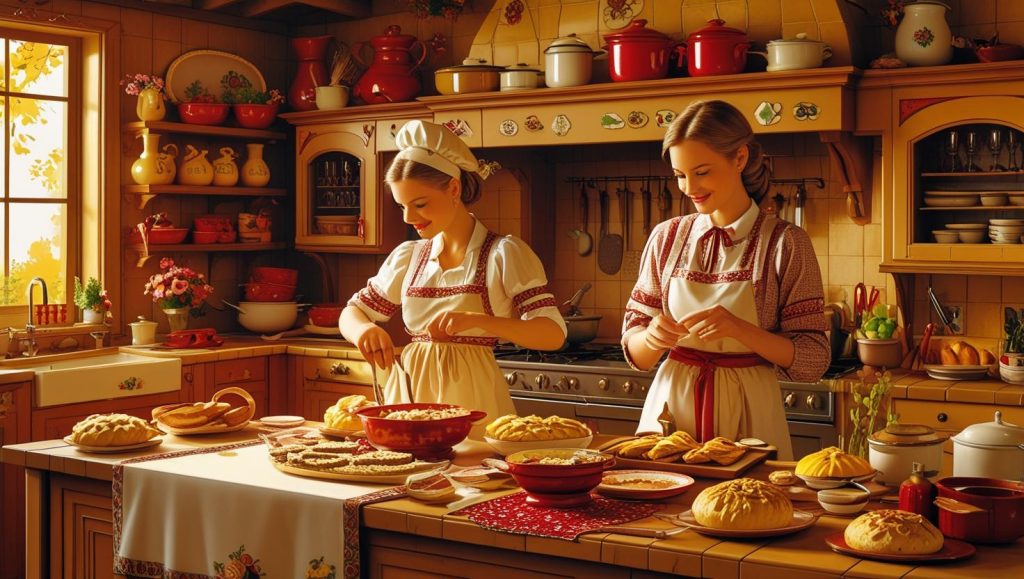The German kitchen ritual involves several precise steps in meal preparation and dining etiquette. In this tradition, attention to detail and quality are highly valued, from the selection of ingredients to the arrangement of the table.
Table of Contents
Additionally, Germans place emphasis on enjoying meals together as a family or community, fostering a sense of unity and social connection. This culinary practice reflects the German culture’s appreciation for efficiency, discipline, and savoring the pleasures of good food. Whether it’s preparing a hearty German dish or savoring a traditional Bavarian brunch, the German kitchen ritual celebrates the art of cooking and dining with a sense of purpose and enjoyment.
Discover more about this unique culinary tradition that shapes German culture and brings people together.
The Influence Of Regional Cultures
Germany is known for its unique and diverse culinary traditions, influenced by a rich tapestry of regional cultures. The historical roots of German cuisine can be traced back to different eras and their respective cultural practices. Culinary differences among German regions are shaped by factors such as local ingredients, traditional cooking techniques, and historical influences.
The country’s geography plays a significant role in shaping traditional German dishes, with coastal regions featuring seafood-based delicacies and more inland areas showcasing hearty and meat-centric fare. From the sauerkraut and bratwurst of Bavaria to the pickled herring of the Baltic Sea, each region offers its own distinct flavors and specialties.
Exploring the German kitchen ritual unveils a fascinating blend of history, culture, and gastronomy, showcasing the vast diversity and rich heritage of this culinary powerhouse.
Key Ingredients In German Kitchen Ritual
German cuisine is known for its unique and flavorful dishes, influenced by a rich culinary history. The key ingredients that make up German cooking vary, but there are some staples that are frequently used. One such essential ingredient is an array of spices and herbs, which bring depth of flavor to German recipes.
From the aromatic warmth of paprika to the distinct kick of mustard seeds, these seasonings add a distinct taste to dishes. Additionally, local ingredients play a significant role in defining German cuisine. From the rich and smoky flavors of locally sourced sausages to the hearty and earthy flavors of root vegetables, these ingredients are key to creating traditional German dishes.
Whether it’s the famous sauerkraut, the beloved pretzels, or the comforting stews, German cuisine celebrates the use of these essential ingredients, making it a true delight for food enthusiasts.
German Kitchen Rituals And Customs
German kitchen rituals and customs are deeply ingrained in the culture. Meal times adhere to strict traditions and rules, with punctuality being highly valued. Festivals and celebrations often revolve around food, highlighting its significance in bringing people together. Home cooking is also cherished, with families taking pride in preparing and sharing traditional German dishes.

The emphasis is on using fresh, local ingredients, and meals are typically enjoyed as a time for bonding and connection. From hearty breakfasts to elaborate dinners, Germans prioritize their kitchen rituals as a way to appreciate and celebrate their culinary heritage.
So, whether it’s a festive occasion or a daily meal, German kitchen customs play a vital role in preserving tradition and fostering a sense of community.
Traditional German Dishes
Traditional German dishes, known as “Hausmannskost” or home cooking, hold great significance in German culture. These iconic recipes have a rich history and are deeply rooted in various regions of the country. Each dish carries its unique flavors and ingredients, showcasing the diversity of German cuisine.
From the hearty and comforting Sauerbraten from Rhineland to the beloved Pretzels from Bavaria, these famous regional specialties have become symbols of German culinary heritage. Whether it’s the aromatic sausages of Thuringia or the delicious Schwarzwälder Kirschtorte (Black Forest Cake) from Baden-Württemberg, these dishes continue to satisfy the palates of both locals and tourists alike.
Exploring the origin and preparation of these traditional German dishes is a delightful journey into the heart of German gastronomy.
Classic German Baking
Baking holds a special place in German households, where the art of creating classic German treats is cherished. From iconic cakes to delectable pastries, these homemade delights are deeply ingrained in the country’s culinary heritage. Each bite of a traditional German baked good is a testament to the rich cultural significance of bread in German cuisine.
Dating back centuries, bread in Germany is more than just a staple food. It symbolizes nourishment, sustenance, and community. German kitchens are filled with the aroma of freshly baked treats, invoking a sense of nostalgia and togetherness. Whether it’s a warm slice of Black Forest cake, a crumbly streusel-topped apple pie, or a soft pretzel, German baking truly captures the essence of tradition and taste.
So, step into a German kitchen and experience the joy of classic baking firsthand.
Modern Twists On Traditional Recipes
German Kitchen Ritual: Modern Twists on Traditional Recipes Contemporary German chefs are infusing international flavors into traditional German cuisine, revitalizing classic dishes. Embracing innovation, these chefs bring a fresh perspective to the culinary scene. From blending Asian spices with sauerkraut to incorporating Middle Eastern herbs into German sausage, the fusion of flavors creates a tantalizing experience.
Not only are these modern twists delicious, but they also showcase the evolving nature of German gastronomy. In addition to reinventing traditional recipes, the popularity of German street food and food trucks has skyrocketed, offering a convenient and diverse culinary experience.
These mobile eateries serve up German favorites like bratwurst and schnitzel in a quick and accessible manner, catering to the fast-paced lifestyles of many. The German Kitchen Ritual has evolved, embracing global influences while keeping the essence of its rich culinary heritage intact.
Traditional German Beverages
German culture is renowned for its traditional beverages, with beer playing a significant role. Germany is home to iconic wine regions, producing a range of exquisite wines. Additionally, German spirits and liqueurs are famous worldwide for their unique flavors and craftsmanship.
These beverages are an integral part of German traditions and rituals, often enjoyed during festivals and social gatherings. German beer, in particular, holds a special place in the hearts of the locals, with a vast array of styles and flavors to choose from.
Whether it’s a refreshing Pilsner, a rich Dunkel, or a fruity Hefeweizen, beer is considered a staple in German cuisine. Similarly, German wines, such as Riesling and Pinot Noir, are celebrated for their quality and versatility. Indulging in these traditional beverages allows one to immerse themselves in the rich cultural heritage of Germany and truly embrace the German kitchen ritual.
Prelude To German Dining
Prelude to German Dining: The significance of appetizers in German meals cannot be underestimated. German soup traditions and specialties are truly exceptional, offering a range of delightful flavors. From the hearty Goulashsuppe to the comforting Kartoffelsuppe, these soups showcase the culinary diversity of Germany.
However, it is the salad course that holds a special place in German dining. Salads not only provide refreshing flavors but also add a burst of color to the table. From the classic green salad dressed with homemade vinaigrette to the popular Gurkensalat made with fresh cucumbers, German salads are visually appealing and tantalizing to the taste buds.
Whether it’s a bowl of soup to warm the soul or an invigorating salad to awaken the palate, German cuisine treasures its prelude to the main course.

German Dining Etiquette
German dining etiquette encompasses various manners and customs during meals. To begin with, toasting and raising glasses play a crucial role in German culture. It is customary to make eye contact and say “Prost!” (cheers) before taking a sip. Proper use of cutlery is also emphasized.
For example, the fork is held in the left hand and the knife in the right. It is considered impolite to rest your elbows on the table during the meal. Additionally, it is important to wait for the host or hostess to begin eating before starting yourself.
Moreover, it is customary to finish all the food on your plate as a sign of appreciation. By following these traditions, you can navigate the German kitchen ritual with finesse and respect.
Credit: www.atlasobscura.com
The Essence Of German Desserts
German desserts hold a special place in culinary traditions, reflecting the country’s rich history. These iconic treats, such as Black Forest cake and apple strudel, have captivated taste buds for centuries. The German kitchen ritual encompasses an indulgence in sweet delights that brings people together.
From the art of pastry-making to the intricacies of preparing intricate desserts, German cuisine celebrates the senses. Each bite tells a story, connecting generations through the shared experience of savoring these delectable treats. Whether it’s the perfect balance of sweet and tart flavors or the comforting aroma of freshly baked goods, German desserts are a true delight.
So, prepare to embark on a journey through German sweet treats and embrace the essence of this culinary heritage.
Exploring German Culinary Tourism
Germany is not only known for its rich history and breathtaking landscapes, but also for its vibrant culinary scene. Exploring German culinary tourism is a journey filled with delightful experiences. From food festivals and markets that showcase the country’s diverse flavors to unique dining experiences that cater to both locals and tourists, Germany has it all.
Whether you’re a food lover looking to indulge in traditional German cuisine or an adventurous traveler seeking new taste sensations, Germany offers a wide range of culinary destinations. From the bustling markets of Berlin to the charming vineyards of the Moselle Valley, each region has its own unique gastronomic offerings.
So, pack your bags and embark on a culinary adventure to discover the delicious delights of German cuisine.
German Kitchen Rituals: A Cultural Legacy
German kitchen rituals have been passed down through generations, keeping alive the country’s rich culinary traditions. Food plays a crucial role in fostering community and identity, binding families and friends together. From the famous sauerkraut to the beloved pretzels, these rituals reflect a deep connection to the land and history.
In a globalized world, the future of German cuisine is evolving, adapting to new tastes and influences. Yet, the essence of these kitchen rituals remains intact, reminding us of the unique cultural legacy that continues to be cherished. As we embrace the future, we must preserve these time-honored traditions, celebrating the flavors and customs that shape our sense of belonging and heritage.
Let us savor the beauty of this culinary heritage and embrace the richness it brings to our lives.
Frequently Asked Questions Of German Kitchen Ritual
What Makes A German Kitchen?
A German kitchen is known for its precision engineering, high-quality materials, and efficient storage solutions.
Why Are German Kitchens So Good?
German kitchens are known for their exceptional quality, innovative design, and meticulous craftsmanship, resulting in superior functionality and durability.
Why Don T German Apartments Come With Kitchens?
German apartments often don’t come with kitchens due to cultural preferences and the desire for flexibility in design.
What Would A Typical Kitchen Look Like In Germany?
A typical kitchen in Germany is functional and efficient, with modern appliances, ample storage space, and a focus on sustainability.
Conclusion
The German kitchen ritual provides a fascinating glimpse into the country’s rich culinary traditions and cultural heritage. From the meticulous attention to detail in food preparation to the emphasis on communal dining, this ritual highlights the importance of food in German culture.
It is a time-honored practice that brings friends and family together, fostering a sense of community and connection. The commitment to using fresh, locally sourced ingredients and the focus on sustainability also reflect Germany’s dedication to environmental consciousness. Whether it’s enjoying a hearty breakfast with freshly baked bread, savoring a comforting lunch of homemade soup, or indulging in a festive dinner, the German kitchen ritual invites us to slow down, appreciate the quality of our food, and savor the simple joys of nourishing our bodies and souls.
So, let’s embrace this wonderful tradition and bring a taste of Germany into our own kitchens!





